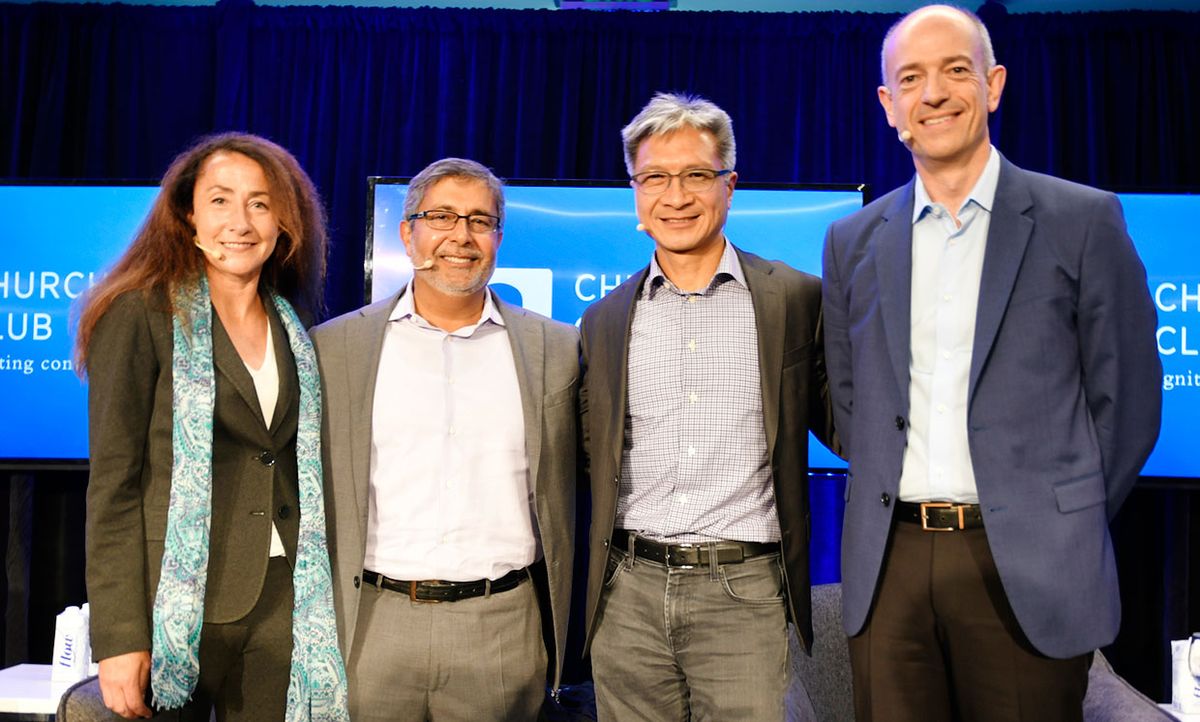We have entered a “Renaissance of Silicon.” That was the thesis of a panel that brought together semiconductor industry CEOs at Micron Technology’s San Jose campus last week. This renaissance, the executives indicated, will lead to an exciting—but not predictable—innovation in chip technology driven by applications that demand more computing power and by the demise of Moore’s Law.
“I’ve never seen a more exciting time in my 40 years in the industry,” said Sanjay Mehrotra, CEO of Micron Technology.
“I hadn’t heard semiconductor and Renaissance in the same sentence in 20 years,” said Tammy Kiely, Goldman Sachs global head of semiconductor investment banking. Kiely moderated the panel, which was organized by the Churchill Club.
The driving force behind this renaissance is “burning necessity,” said Xilinx CEO Victor Peng. Arm CEO Simon Segars agreed.
“For last 15 years, the driver of growth was mobile,” Segars said. “Over the last five years, the industry was in a bit of a lull. Then all of a sudden there is this combination of effects.” He listed cloud computing, handheld computing, IoT devices, 5G, AI, and autonomous vehicles as contributing to the boom. “Lots of things are coming together at once,” he said, along with “fundamental algorithm development.”
All these things, Xilinx’s Peng said, mean that the industry will have to come up with a way to improve computing power and storage by a factor of 100—if not 1000—over the next 10 years. That will require new architectures, new packaging—and a new way of looking at the entire ecosystem. “The entire data center is a computer,” he said, pointing out that computation will have to happen all over it, in memory, in switches, even in the communications lines.
Getting a 100- to 1000-times improvement in processing power will also require innovation in software, Peng continued. “People got used to Moore’s law enabling them to throw cycles away to enable abstraction. It’s not that simple anymore…. When you need 100 times [improvement], you don’t evolve the same architecture, you start all over. When Moore’s law was chipping away every year, you didn’t rethink the entire problem. But now you have to look at hardware and software together.”
Concerned About Climate Change
The panelists reminded the audience that it’s also no longer just about making chips better, faster, and cheaper (or these days, as Peng points out, getting one or two of those things at best). The semiconductor industry also has to drive power consumption down.
“Power consumption is an existential question, [considering] climate change,” Peng said, noting that data centers now consume about 10 percent of the world’s electric power. “That cannot scale exponentially and be sustainable.” Getting power consumption down is, he said, “not only a huge business opportunity but a moral imperative.”
Climate change, Segars said, will be a big driver for semiconductor innovation over the next five years. The industry, he said, will have to “create different computing engines to solve things in a more efficient way… [and innovate] on microarchitectures to get power down. In the long term, [we have to] think about workloads. The ultimate architecture might be dedicated engines for different commonly executed tasks that do things in a more efficient way.”
Segars also suggested that we ought to consider the bigger picture when weighing the power costs of computing. “Smart cities,” he said, “may result in more energy getting burned in data centers to process the IoT data, but their net could be energy savings.”
Don’t Expect a Startup Surge
This boom in innovation is unlikely to lead to a boom in startups, the panelists agreed. That may be counter to what we expect from Silicon Valley, but it’s the reality, they indicated.
“The cost of taping a chip out at 5 nanometers is astronomical, so unless you can amortize costs over multiple designs, nobody can afford it,” Segars said. “So we will need the large semiconductor companies to keep progress aggressive. Of course, the more expensive it is, the fewer that can afford to do it. But unlike other industries, like steel, I don’t think innovation is going to dry up.”
“Larger companies have a greater ability to invest in future innovations, to make big bets,” Mehrotra agreed. However, he said, “there are startups that are forming that are working on silicon aspects. Certainly what Simon [Segars] said about increased complexity and the time and money [involved] compared to the past is true.” But, he said, at least some architecture innovation is happening outside the big companies—though “not the way it was when I joined the industry 40 years ago.”
“There has been a lot of VC money going into AI chip companies,” Segars concurred. But, he predicts that, “unfortunately I don’t think we are going back to the days where Sand Hill Road is going to hand out wheelbarrows of money to people to design chips.”
Tekla S. Perry is a senior editor at IEEE Spectrum. Based in Palo Alto, Calif., she's been covering the people, companies, and technology that make Silicon Valley a special place for more than 40 years. An IEEE member, she holds a bachelor's degree in journalism from Michigan State University.



